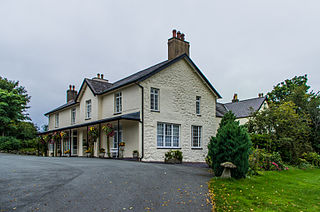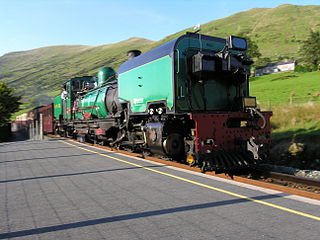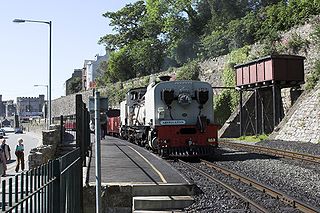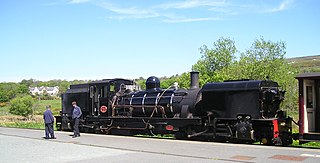
The Porthmadog, Beddgelert and South Snowdon Railway (PB&SSR) was a 1 ft 11 1⁄2 in narrow gauge railway intended to connect Porthmadog with the North Wales Narrow Gauge Railways link terminus at Rhyd Ddu. Although some of the line was constructed between 1901 and 1906, it never opened and eventually became part of the Welsh Highland Railway.

The North Wales Narrow Gauge Railways (NWNGR) was a railway company that planned to build a number of inter-connected 1 ft 11 1⁄2 in narrow-gauge railways across North Wales. The first two of these lines - jointly known as the "Moel Tryfan Undertaking" - were authorised by Act of Parliament 1872 and were built and opened in the 1870s. The original main line ran from Dinas Junction to Bryngwyn and opened in 1877. The second line was a branch from Tryfan Junction to South Snowdon, though shortly after opening, the company designated the Tryfan Junction to Bryngwyn section as the branch, and the Dinas Junction to South Snowdon section as the main line.

The Croesor Tramway was a Welsh, 2 ft narrow gauge railway line built to carry slate from the Croesor slate mines to Porthmadog. It was built in 1864 without an Act of Parliament and was operated using horse power.

Rhyd Ddu is a small village in Snowdonia, North Wales which is a starting point for walks up Snowdon, Moel Hebog, Yr Aran and the Nantlle Ridge.

Dinas is a large hamlet near Bontnewydd, Caernarfon, in Gwynedd, north-west Wales.

Llyn Cwellyn is a reservoir in North Wales which supplies drinking water to parts of Gwynedd and Anglesey. It lies on the Afon Gwyrfai in Nant y Betws between Moel Eilio and Mynydd Mawr in the northern part of Snowdonia National Park. It has an area of 215 acres (0.87 km2), and is over 120 ft (37 m) deep. At the southern end is the small village of Rhyd Ddu.

Rhyd Ddu is a station on the narrow gauge Welsh Highland Railway, which was built in 1881 as the North Wales Narrow Gauge Railways Moel Tryfan Undertaking to carry dressed slate to Dinas Junction on the LNWR. It has also previously been named both "Snowdon" and "South Snowdon".

Snowdon Ranger is a station on the narrow gauge Welsh Highland Railway, which was built in 1878 as the North Wales Narrow Gauge Railways Moel Tryfan Undertaking, to carry dressed slate to Dinas Junction on the LNWR. The station was originally known as Quellyn Lake but was renamed after the path to the Summit of Snowdon popularised by, and named after, the local mountain guide, "The Snowdon Ranger", who went by that name for many years. Certainly the name "Snowdon Ranger" was in common use on company timetables from as early as 1879, and that of the adjacent Snowdon Ranger Hotel from at least 1869.

Plas-y-Nant is an unstaffed halt on the narrow gauge Welsh Highland Railway.

Meillionen railway station is a halt on the Welsh Highland Railway. It opened to the public when the section of line between Rhyd Ddu and Beddgelert re-opened on 8 April 2009.

Beddgelert railway station is a railway station on the narrow gauge Welsh Highland Railway in North Wales.

Pont Croesor is a railway halt in Wales, on the Welsh Highland Railway, which runs through the Snowdonia National Park from Caernarfon to Porthmadog. It is located on the section between the stations of Hafod y Llyn and Pen-y-Mount Junction.

The A4085 is a 20-mile road between Caernarfon and Penrhyndeudraeth in North Wales that runs through the scenic Aberglaslyn Pass. There are several locations where the road is of substandard width.
The restoration of the Welsh Highland Railway has a colourful and complex history. This article provides the modern history.
The original Welsh Highland Railway (WHR) owed its existence to the narrow gauge railways and tramways built to serve commercial slate traffic from slate quarries and other mineral extraction operations along its route.
Hafod y Llyn is a halt in North Wales on the Welsh Highland Railway, located between Beddgelert and Pont Croesor. It had been a halt, with a siding for a period on the original WHR, and a temporary terminus during the rebuilding of the line.




















